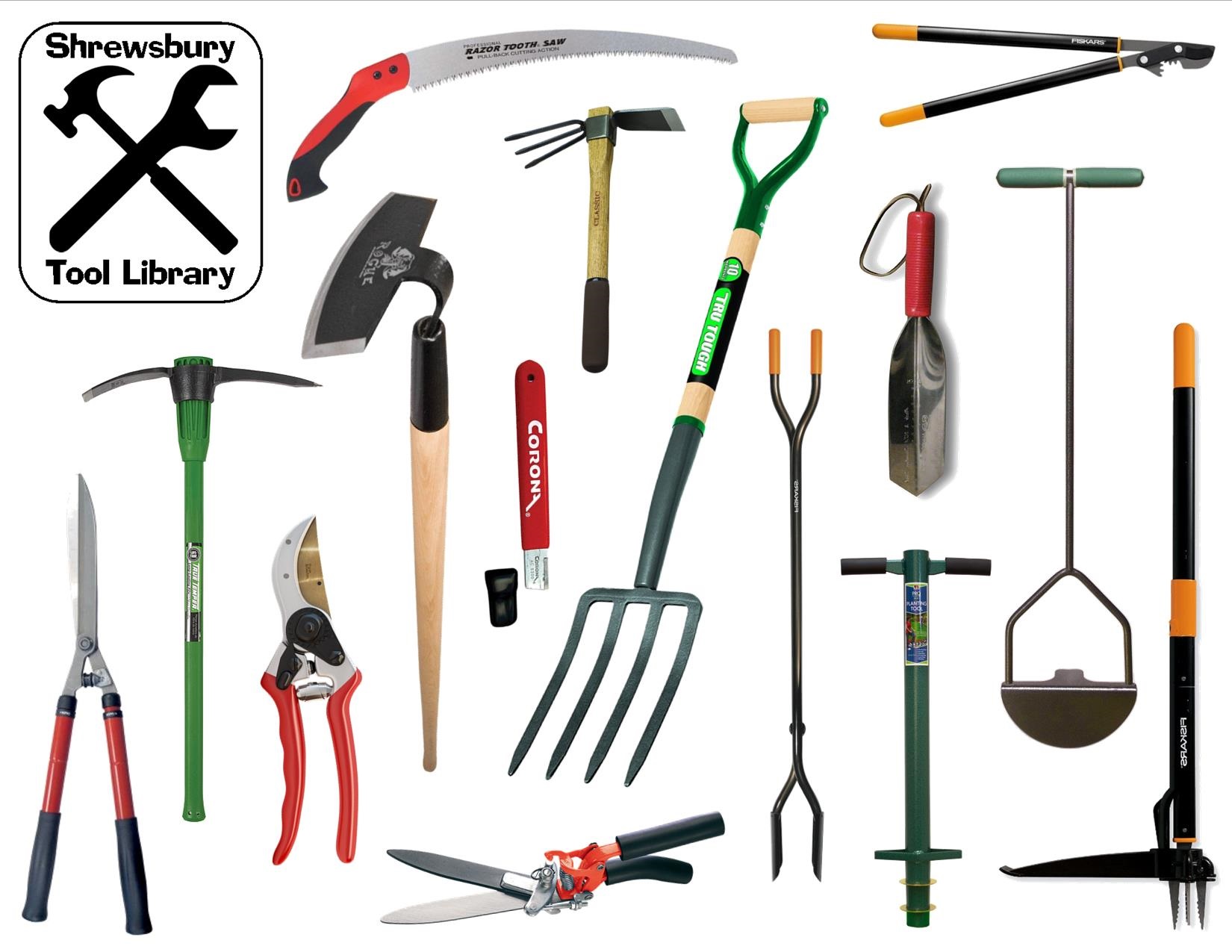National Puzzle Day is January 29th: if you start adding to your collection now, you’ll have enough time to plan a puzzle competition to celebrate!
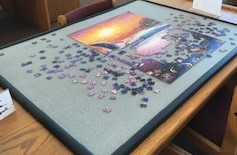
Puzzles are some of the easiest items to add to your collection: you can get stacks of them for little money at yard sales, flea markets, and the like, and once you have a few, patrons are likely to ask you if you want donations. You could even post a sign asking if any patrons want to donate their puzzles and get your entire collection from donations! Most people assemble a puzzle one time after buying it and don’t know what to do with it after that.
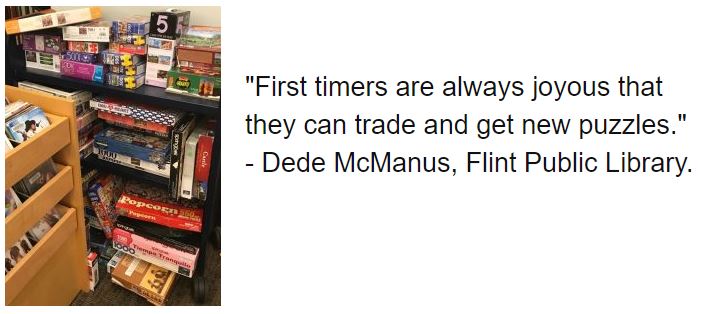
Your collection will probably become very popular very quickly as puzzlers spread the word: “people who never use the library seem to know that the puzzles are here,” according to Flint Public Library. This is probably because puzzlers don’t like to do the same puzzle twice, so they’re always seeking out new puzzles. Puzzles are so popular, they can even be used to attract people to part of your collection that deserves more attention, according to Paulina Borrego from UMass Amherst.
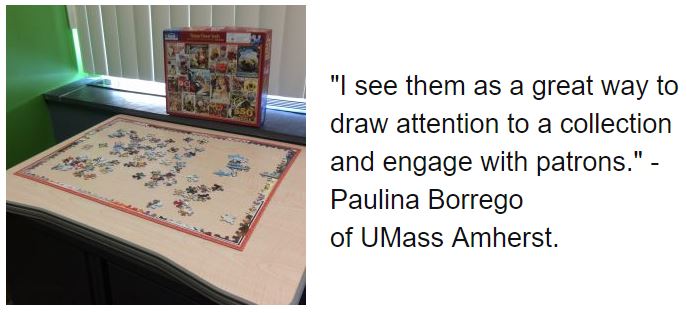
Puzzles are one of the items that will probably need to be discarded more quickly than most of your collection, but since donations come so easily, it’s less of an issue to discard. Norwood discards immediately after they discover missing pieces. After all, who wants to get to the end of a puzzle and discover a tiny gap in it?
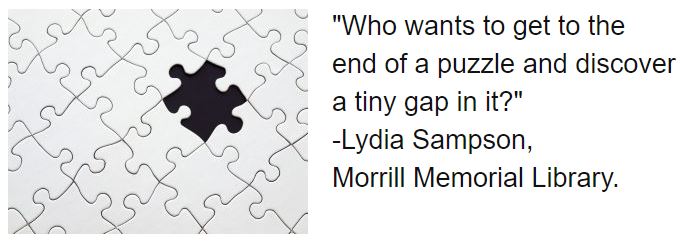
Larger floor puzzles are less likely to circulate, since replacement cost is higher for those, however, some libraries still do circulate them. For those, they usually are stamped with the library name on the back of each piece and displayed in large hanging bags.
!["We can't possibly count all of the pieces [but] have had great luck so far with the puzzles staying intact." -Jill Clements, Watertown.](https://masslibsystem.org/wp-content/uploads/puzzle-03-watertown-02.jpg)
Circulating puzzles are usually accepted back on faith of being intact, and discarded later if it turns out to be missing pieces, rather than expecting a librarian to stop and count pieces immediately on check in. In the case of puzzles for very young children with 48 pieces or fewer, they’re quick enough to count you can probably check when they’re returned. Volunteers are usually happy to count puzzle pieces, even the larger sets, but if you don’t have volunteer resources for this, one solution is to attach a label asking patrons to let you know if they discover a missing piece.
Many puzzles are kept for in library use. Tufts University came up with the idea of placing puzzles on a table in the entranceway so stressed students will stop and take a break in between classes.
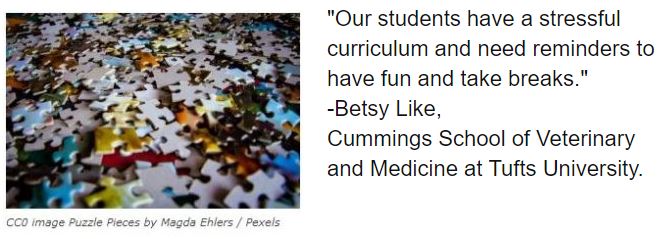
“Our students have a stressful curriculum and need reminders to have fun and take breaks.” -Betsy Like, Cummings School of Veterinary and Medicine at Tufts University.
Librarians report that issues with their puzzles are few and far between, however, the most common issue is the one that every Library of Things collection faces, which is how to catalog. Because puzzles tend to need to be replaced so quickly, many libraries find alternate options to barcode tagging and adding to their circulation system, such as KitKeeper. The other rare problem is the possibility of children disrupting the work of serious adult puzzlers. One librarian new to puzzles raised the concern of packaging so the boxes don’t split open: if you have recommendations, please post a comment below!
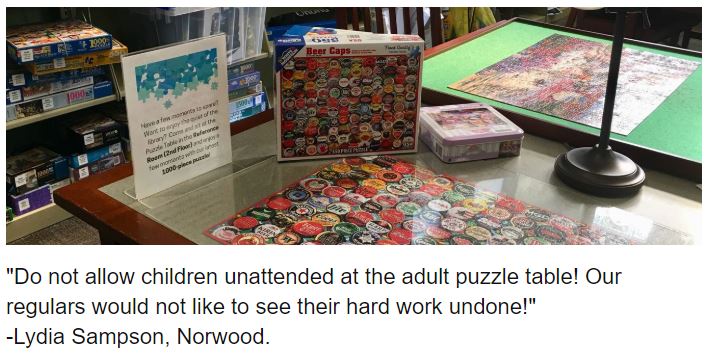
Want to see more fantastic collections? Read our other Library of Things Blog posts, or check out our Library of Things LibGuide.
Article by Laura M. Bogart, with contributions by Robin Brzozowski and Robin Shtulman of Athol Public Library; Karen E. Stinchfield of Cushman Library, Bernardston; Ann Abrams of Temple Israel, Boston; Julie Kellndorfer of Brookline Village Library; Rachael Shea of Clark University; Lisa Cunningham of Dennis Public Library; Jocelyn Tavares of Dighton Public Library; Wendy Payette of East Brookfield Public Library; Sharon A. Bernard of Fitchburg Public Library; Virginia K. Johnson of John Curtis Free Library, Hanover; Sia Stewart of Kingston Public Library; Sheila Parks of Lanesborough Public Library; Cyndee Marcoux of Ventress Memorial Library, Marshfield; Margaret Perkins of Medway Public Library; Lori Salatto of Middleboro Public Library; Dede McManus of Flint Public Library, Middleton; Paula Elliot of Forbes Library, Northampton; Maggie Holmes of Richards Memorial Library, North Attleboro; Kate Tigue and Lydia Sampson of Morrill Memorial Library, Norwood;Jodi Levine of Pelham Library; Carol Gafford of Swansea Free Public Library; Betsy Like of Tufts University, North Grafton; Paulina Borrego of UMass Amherst; Jamie Kallestad and Jill Martin Clements of Watertown Free Public Library; Barbara Bryant of Whitman Public Library; Kirsten Rose of David and Joyce Milne Public Library, Williamstown.

